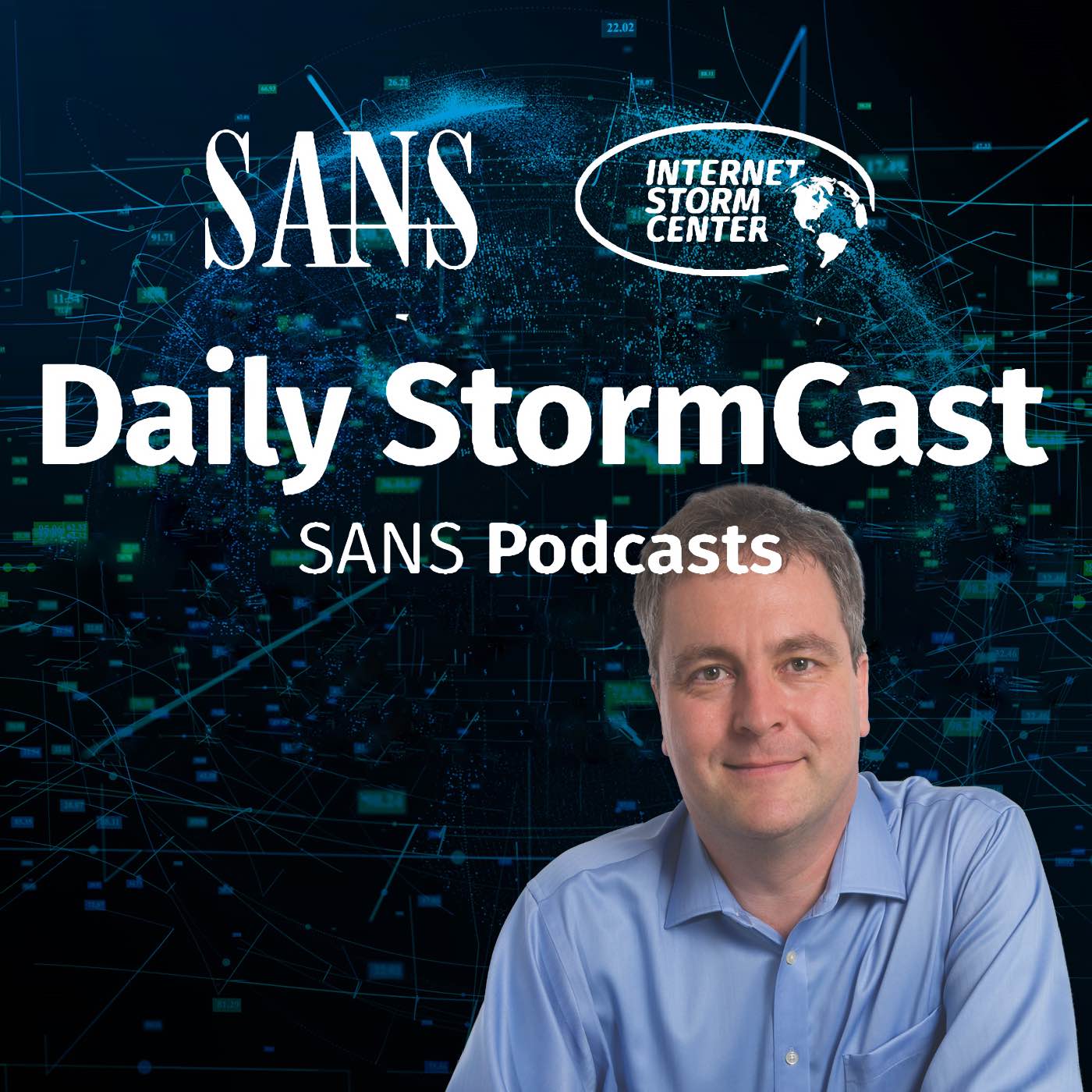Handler on Duty: Xavier Mertens
Threat Level: green
Podcast Detail
SANS Stormcast Wednesday, May 21st 2025: Researchers Scanning the Internet; Forgotten DNS Records; openpgp.js Vulneraiblity
If you are not able to play the podcast using the player below: Use this direct link to the audio file: https://traffic.libsyn.com/securitypodcast/9460.mp3

Researchers Scanning the Internet; Forgotten DNS Records; openpgp.js Vulneraiblity
00:00
My Next Class
| Network Monitoring and Threat Detection In-Depth | Online | Central European Time | Dec 15th - Dec 20th 2025 |
| Application Security: Securing Web Apps, APIs, and Microservices | Orlando | Mar 29th - Apr 3rd 2026 |
Researchers Scanning the Internet
A “newish” RFC, RFC 9511, suggests researchers identify themselves by adding strings to the traffic they send, or by operating web servers on machines from which the scan originates. We do offer lists of researchers and just added three new groups today
https://isc.sans.edu/diary/Researchers%20Scanning%20the%20Internet/31964
Cloudy with a change of Hijacking: Forgotten DNS Records
Organizations do not always remove unused CNAME records. An attacker may take advantage of this if an attacker is able to take possession of the now unused public cloud resource the name pointed to.
https://blogs.infoblox.com/threat-intelligence/cloudy-with-a-chance-of-hijacking-forgotten-dns-records-enable-scam-actor/
Message signature verification can be spoofed CVE-2025-47934
A vulnerability in openpgp.js may be used to spoof message signatures. openpgp.js is a popular library in systems implementing end-to-end encrypted browser applications.
https://github.com/openpgpjs/openpgpjs/security/advisories/GHSA-8qff-qr5q-5pr8
Discussion
New Discussions closed for all Podcasts older than two(2) weeks
Please send your comments to our Contact Form
| Network Monitoring and Threat Detection In-Depth | Online | Central European Time | Dec 15th - Dec 20th 2025 |
| Application Security: Securing Web Apps, APIs, and Microservices | Orlando | Mar 29th - Apr 3rd 2026 |
| Network Monitoring and Threat Detection In-Depth | Amsterdam | Apr 20th - Apr 25th 2026 |
| Application Security: Securing Web Apps, APIs, and Microservices | San Diego | May 11th - May 16th 2026 |
| Network Monitoring and Threat Detection In-Depth | Online | Arabian Standard Time | Jun 20th - Jun 25th 2026 |
| Network Monitoring and Threat Detection In-Depth | Riyadh | Jun 20th - Jun 25th 2026 |
| Application Security: Securing Web Apps, APIs, and Microservices | Washington | Jul 13th - Jul 18th 2026 |
Podcast Transcript
Hello and welcome to the Wednesday, May 21st, 2025 edition of the SANS Internet Storm Center's Stormcast. My name is Johannes Ulrich and this episode brought to you by the Graduate Certificate Program in Cyber Defense Operations is recorded again in Jacksonville, Florida. Well, today's diary is not a hot new threat for a change, but something that has been happening for a while. The reason I wrote about it today was earlier today, Caleb in our Slack channel asked the question whether or not researchers scanning the internet actually obey RFC 9511. Now, you may ask, what is RFC 9511? It's a standard that suggests researchers who are scanning the internet, well, should do something to identify their scans as originating from a research project and also help people who are targeted by these scans to contact whoever is the origin organization of these scans. There are a number of methods that this particular RFC proposes. For example, you can set up a web server on the system performing the scans and then a standard file on that web server will identify the origin of the scan. Also, you can basically add some information like a URL or such as part of the payload of the data that you're sending. The most common implementation I see is that researchers are adding a string like a URL to the user agent when they're scanning a web applications. And that's, of course, one thing that we are looking at. For a few years now, we are publishing a list of IP addresses that we consider part of research organizations performing scan. Now, some of them are commercial, but the idea is the same that they're scanning the internet to, for example, identify infected systems or identify weakly configured systems. Shodan probably being the largest one. Census also being quite verbose and oftenly cited when it comes to these type of scans. Overall, 33,000 addresses are currently in our database. As I wrote the diary, we had 36 groups. Well, while I wrote the diary, I looked at a couple of other logs and actually now we're up to 39 groups that we are tracking for these scans. How do we know that these are not just attackers claiming to be researchers? And the short answer is we don't know. The behavior is sort of consistent with what I would researchers expect to do. They may hit like a URL, like a .git or something like this, looking for exposed .git directories. But they don't necessarily then send an actual exploit and they try not to harm the systems that they are scanning. But then again, that's why it's important that they identify themselves. And certainly not all of them are doing so. And there are certainly some that I would say a little bit in the shady, odd kind of range where it's not really clear how benevolent their research actually is. On the same note, if you are planning to do a scan like this, well, first take a look at some of the data sets that are already out there. For example, Census is publishing quite good data sets. There's a ton of scanning already happening for these kind of research purposes. Actually, in some cases, I think we have seen about 30% of the scans that hit individual systems being just attributed to these researchers. And maybe I'll publish an update about what the exact number is later in the week if I get around to collect some of that data. And then we got a great blog by Infoblox. Well, the DNS people. So, of course, it is about DNS that tells you why you need to keep your DNS house in order. In particular, again, the problem with dangling CNAME records. CNAME records are essentially aliases. So, you can redirect queries for one of your host names to another host name that, of course, can be at any other domain. This is often used to point users to cloud resources. So, you set up a particular AWS website or bucket. And now you would like to use your domain name to point users to that particular resource. Well, the option you have is just point a CNAME at it. The problem is that users often don't remove those CNAME when they are no longer used. What happens now is that the particular host name it points to in the case of HazyHawk, the operation that Infoblox here observed. It's usually a cloud resource. So, the attacker will now take over that cloud resource. Your host name still points to that cloud resource. And with that, the attacker now gained a foothold inside your domain, essentially inserting content into your website. This has been a common issue where various variation of these problems, essentially registering CNAME, registered domains, and not renewing them or not maintaining them after they no longer are being abused by attackers. Now, Infoblox points out that this is not a trivial attack because in order to find these delegations, well, the attacker has to usually sift through quite a bit of DNS data and also needs to have access to a lot of DNS data. Well, in the last few years, we had many applications that do offer end-to-end encryption for browser-based applications. The goal is always the same. We keep the files encrypted on the server, and then they are being decrypted in the browser once they are received by the user. And whatever password is such being used is usually encrypted itself using the user's password. Well, there is a problem here that the integrity of the systems depends on the integrity of any JavaScript. Crypto libraries being used here. One that's particularly popular is OpenPGP. Well, this library is vulnerable in that it did not correctly verify message signatures, which then can be spoofed, which in a limited way at least does endanger the integrity of these encrypted messages being viewed using this library. Interesting vulnerability. And if you're working on a system like this, please make sure that you are updating this library. Well, this is it for today. So thanks for listening. And of course, a couple of you noticed that at the beginning, I always reference lately some sans.edu programs. It's really just, well, they're paying the bills anyway for this podcast since I'm working for them. So may as well give them some credit if you're happy to talk to anybody about joining one of these programs. Well, let them know that you like this podcast. And with that, thanks and talk to you again tomorrow. Bye.










